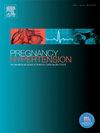在英国三级医院使用血管生成生物标志物对子痫前期诊断测试实施后的临床结果
IF 2.9
4区 医学
Q2 OBSTETRICS & GYNECOLOGY
Pregnancy Hypertension-An International Journal of Womens Cardiovascular Health
Pub Date : 2025-06-03
DOI:10.1016/j.preghy.2025.101227
引用次数: 0
摘要
目的评估血管生成生物标志物(sFLT1:PlGF,罗氏Elecsys®)在英国三级产科中心的实际应用,以提高先兆子痫的诊断。研究设计回顾性队列研究。主要结局指标:从常规妊娠资料中整理产前结局,并比较引入sFLT1:PlGF比值检测前后的结果。对于那些接受检测的女性(2019年9月至2021年2月),记录先兆子痫的诊断和不良事件。结果从常规记录的数据来看,34-37周出生的比例有上升趋势(4.8% vs 5.4%;P = 0.054),试验实施后围产儿粗死亡率无显著差异。660例sFLT1/PlGF检测后的妊娠获得了详细的结果,其中30.7%发生先兆子痫,153例(23.2%)需要在37周前分娩。sFLT:PlGF比值≥85的孕妇中,99%临床诊断为先兆子痫,6/13假阴性(比值<;38)是双胎妊娠。较高的sFLT:PlGF比率或较低的PlGF值与早产和较低的出生体重百分位数相关,而较高的sFLT水平与较短的出生间隔相关。结论引入sFLT:PlGF比值检测疑似子痫前期表现出非常高的诊断准确性,但与产妇人群围产期结局的可测量差异无关。sFLT:PlGF检测确定了一个比值≥85的妇女亚组,她们更有可能需要高依赖性护理,然而sFLT-1或PlGF的绝对水平与孕产妇或围产期疾病严重程度的临床特征没有很强的相关性。本文章由计算机程序翻译,如有差异,请以英文原文为准。
Clinical outcomes following implementation of diagnostic testing for pre-eclampsia within a UK tertiary hospital setting using angiogenic biomarkers
Objective
To evaluate real-world implementation of angiogenic biomarkers (sFLT1:PlGF, Roche Elecsys®) to enhance the diagnosis of pre-eclampsia within a UK tertiary maternity centre.
Study design
Retrospective cohort study.
Main outcome measures
Perinatal outcomes were collated from routine pregnancy data and compared before and after the introduction of sFLT1:PlGF ratio testing. For those women receiving a test (September 2019 to Feb 2021), the diagnosis of pre-eclampsia and adverse events were recorded.
Results
From routinely recorded data, there was a trend towards a rise in the proportion of births 34–37 weeks (4.8 % vs 5.4 %; p = 0.054) after test implementation, crude perinatal mortality rates were not different. Detailed outcomes were available for 660 pregnancies following sFLT1/PlGF testing of whom 30.7 % developed pre-eclampsia, 153 (23.2 %) required birth before 37 weeks. 99 % of the pregnancies complicated by a sFLT:PlGF ratio ≥ 85 had a clinical diagnosis of pre-eclampsia, 6/13 false negative tests (ratio < 38) were in twin pregnancies. Higher sFLT:PlGF ratios or lower PlGF values correlated with preterm birth and lower birth weight percentiles, while higher sFLT levels were associated with a reduced test to birth interval.
Conclusions
Introduction of sFLT:PlGF ratio testing for suspected pre-eclampsia demonstrated very high diagnostic accuracy but was not associated with a measurable difference in perinatal outcomes within the maternity population. sFLT:PlGF testing identified a sub-group of women with ratio values ≥ 85 that were more likely to require high-dependency care, however absolute levels of either sFLT-1 or PlGF were not strongly associated with clinical features of maternal or perinatal disease severity.
求助全文
通过发布文献求助,成功后即可免费获取论文全文。
去求助
来源期刊

Pregnancy Hypertension-An International Journal of Womens Cardiovascular Health
OBSTETRICS & GYNECOLOGYPERIPHERAL VASCULAR-PERIPHERAL VASCULAR DISEASE
CiteScore
4.90
自引率
0.00%
发文量
127
期刊介绍:
Pregnancy Hypertension: An International Journal of Women''s Cardiovascular Health aims to stimulate research in the field of hypertension in pregnancy, disseminate the useful results of such research, and advance education in the field.
We publish articles pertaining to human and animal blood pressure during gestation, hypertension during gestation including physiology of circulatory control, pathophysiology, methodology, therapy or any other material relevant to the relationship between elevated blood pressure and pregnancy. The subtitle reflects the wider aspects of studying hypertension in pregnancy thus we also publish articles on in utero programming, nutrition, long term effects of hypertension in pregnancy on cardiovascular health and other research that helps our understanding of the etiology or consequences of hypertension in pregnancy. Case reports are not published unless of exceptional/outstanding importance to the field.
 求助内容:
求助内容: 应助结果提醒方式:
应助结果提醒方式:


